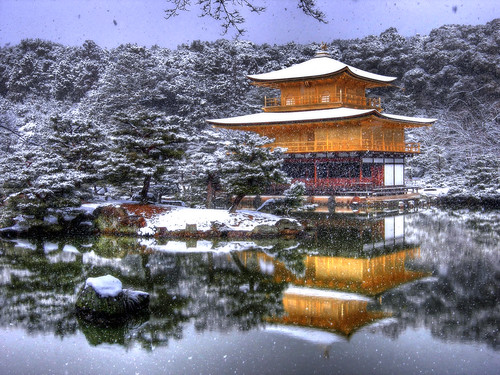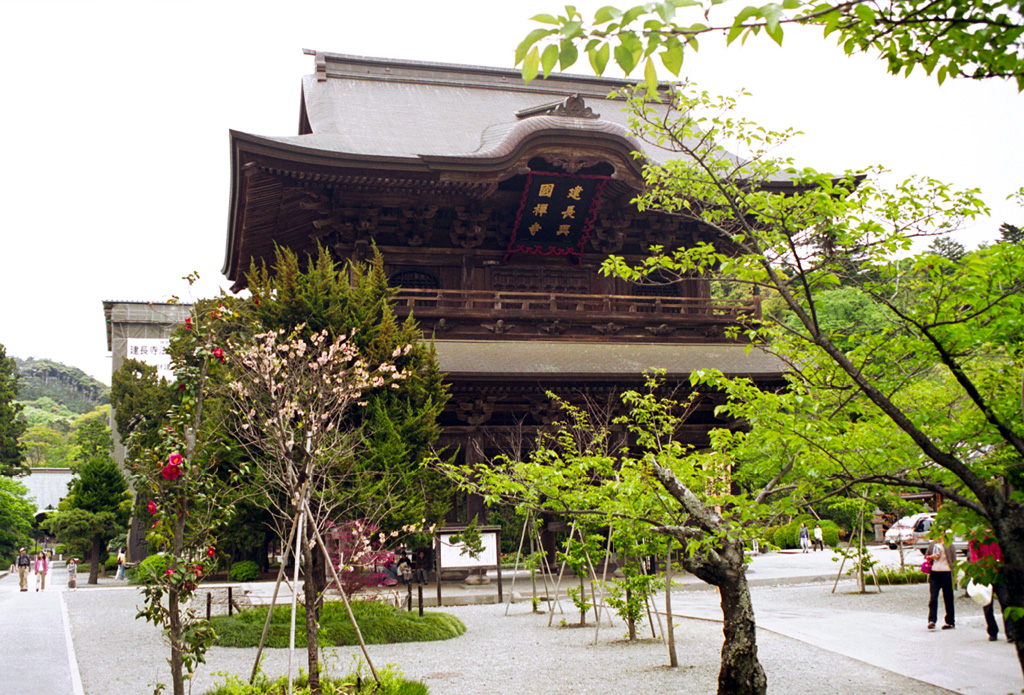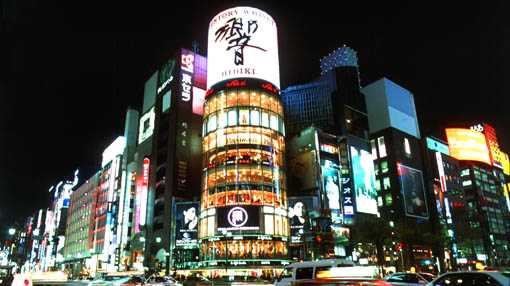
Tōdai-ji (東大寺 Tōdai-ji, Eastern Great Temple), is a Buddhist temple complex located in the city of Nara, Japan. Its Great Buddha Hall (大仏殿 Daibutsuden), the largest wooden building in the world, houses the world's largest bronze statue of the Buddha Vairocana, known in Japanese simply as Daibutsu (大仏). The temple also serves as the Japanese headquarters of the Kegon school of Buddhism. The temple is a listed UNESCO World Heritage Site as "Historic Monuments of Ancient Nara", together with seven other sites including temples, shrines and places in the city of Nara. Sika deer, regarded as messengers of the gods in the Shinto religion, roam the grounds freely.(wikipedia.org)
9. Miyajima

The shrine is dedicated to the three daughters of the Shinto deity of seas and storms Susano-o no Mikoto, brother of the great sun deity, Amaterasu (the tutelary deity of the Imperial household). The first shrine buildings were probably erected in the 6th century, and the shrine has been destroyed many times. The present shrine dates from the mid-16th century, having been rebuilt in keeping with its earlier 12th century design.
The current sixteenth century shrine follows the design established in 1168, when funds were provided by the warlord Taira no Kiyomori. The shrine's construction, consisting of pier-like structures built over the bay, is due to the holy status that the island once commanded. Commoners were historically not allowed to set foot on the island, and had to approach by boat, entering through the gate that appears to float. Beside the shrine is a noh stage.
The dramatic gate (torii) of Itsukushima Shrine is one of Japan's most popular tourist attractions[2], and the view of the gate in front of the island's Mount Misen is classified as one of the Three Views of Japan (along with the sand bar Amanohashidate, and Matsushima Bay). The gate has existed since 1168, though the current gate dates back to 1875. The gate, built of camphor wood, is about 16 metres high and was built in a four-legged style to provide additional stability.
The gate only appears to be floating at high tide; when the tide is low, the gate is surrounded by mud and can be accessed by foot from the island. It is common practice for visitors to place coins in the cracks of the legs of the gate and make a wish. Gathering shellfish near the gate is also popular at low tide. Many locals use the shellfish they gather for their miso soup. At night, powerful lights on the shore illuminate the gate.
Retaining the purity of the shrine is so important that since 1878, no deaths or births were permitted at the shrine.[citation needed] To this day, burials on the island are still forbidden.
On September 5, 2004, the shrine was severely damaged by Typhoon Songda. The boardwalks and roof were partially destroyed, leading to its temporary closure.(wikipedia.org)
8. Mastumoto Castle

The keep (tenshukaku), which was completed in the late 16th century, maintains its original wooden interiors and external stonework. It is listed as a National Treasure of Japan.
Matsumoto Castle is a flatland castle (hirajiro) because it is not built on a hilltop or amid rivers, but on a plain. Its complete defences would have included an extensive system of inter-connecting walls, moats and gatehouses. (wikipedia.org)
7. Nikko

Nikkō (日光市 Nikkō-shi, literally "sunlight" or "sunshine") is a city located in the mountains of Tochigi Prefecture, Japan. Located approximately 140 km north of Tokyo and approximately 35 km west of Utsunomiya, the capital of Tochigi, it is a popular destination for Japanese and international tourists, housing the mausoleum of shogun Tokugawa Ieyasu (Nikkō Tōshō-gū) and that of his grandson Iemitsu (Iemitsu-byō Taiyū-in), as well as the Futarasan Shrine, which dates to the year 767. There are also many famous hot springs (onsen) in the area. Elevations range from 200 to 2,000 m. The mountains west of the main city are part of Nikkō National Park and contain some of the country's most spectacular waterfalls and scenic trails.
As of January 1, 2008, the city has an estimated population of 92,181.(wikipedia.org)
6. Kinkakuji
As of January 1, 2008, the city has an estimated population of 92,181.(wikipedia.org)
6. Kinkakuji

Kinkaku-ji (金閣寺 Temple of the Golden Pavilion), also known as Rokuon-ji (鹿苑寺 Deer Garden Temple), is a Zen Buddhist temple in Kyoto, Japan. The garden complex is an excellent example of Muromachi period garden design. It is designated as a National Special Historic Site and a National Special Landscape, and it is one of 17 World Cultural Heritage sites in Kyoto. It is also one of the most popular buildings in Japan, attracting a large number of visitors annually.(wikipedia.org)
5. Kamakura


The Great Buddha of Kamakura is a monumental outdoor bronze statue of Amitābha Buddha located at the Kōtoku-in Temple in Kamakura, Kanagawa Prefecture, Japan. The bronze statue probably dates from 1252, in the Kamakura period, according to temple records. It was preceded by a giant wooden Buddha, which was completed in 1243 "after five years of continuous labor", the funds having been raised by Lady Inadano-Tsubone and the Buddhist priest Joukou of Toutoumi. That wooden statue was damaged by a storm in 1248, and the hall containing it was destroyed, so Joukou suggested making another statue of bronze, and the huge amount of money necessary for this and for a new hall was raised for the project. The sculptors were Ono Goroemaon and Tanji Hisatomo. At one time, the statue was gilded. There are still traces of gold leaf near the statue's ears. The hall was destroyed by a storm in 1334, was rebuilt, and was damaged by yet another storm in 1369, and was rebuilt yet again.
It is unclear, however, whether the statue constructed in 1252 is the same statue as the present statue. The building housing the statue was washed away in the tsunami of September 20th, 1498 during the Muromachi period.
The statue is approximately 13.35 meters tall and weighs approximately 93 tons. The statue is hollow, and visitors can view the interior. Many visitors over the years have left graffiti on the inside of the statue. At one time, there were thirty-two bronze lotus petals at the base of the statue, but only four remain, and they are no longer in place. A notice at the entrance to the grounds reads, "Stranger, whosoever thou art and whatsoever be thy creed, when thou enterest this sanctuary remember thou treadest upon ground hallowed by the worship of ages. This is the Temple of Bhudda (sic) and the gate of the eternal, and should therefore be entered with reverence."
Since the last hall was washed away in 1498, the Great Buddha has stood in the open air.
The Great Kanto Earthquake of 1923 destroyed the base the statue sits upon, but the base was repaired in 1925. Repairs to the statue were carried out in 1960-1961, when the neck was strengthened and measures were taken to protect it from earthquakes.(wikipedia.org)
It is unclear, however, whether the statue constructed in 1252 is the same statue as the present statue. The building housing the statue was washed away in the tsunami of September 20th, 1498 during the Muromachi period.
The statue is approximately 13.35 meters tall and weighs approximately 93 tons. The statue is hollow, and visitors can view the interior. Many visitors over the years have left graffiti on the inside of the statue. At one time, there were thirty-two bronze lotus petals at the base of the statue, but only four remain, and they are no longer in place. A notice at the entrance to the grounds reads, "Stranger, whosoever thou art and whatsoever be thy creed, when thou enterest this sanctuary remember thou treadest upon ground hallowed by the worship of ages. This is the Temple of Bhudda (sic) and the gate of the eternal, and should therefore be entered with reverence."
Since the last hall was washed away in 1498, the Great Buddha has stood in the open air.
The Great Kanto Earthquake of 1923 destroyed the base the statue sits upon, but the base was repaired in 1925. Repairs to the statue were carried out in 1960-1961, when the neck was strengthened and measures were taken to protect it from earthquakes.(wikipedia.org)
4. Bomb Dome

Hiroshima Peace Memorial, commonly called the Atomic Bomb Dome or A-Bomb Dome (原爆ドーム Genbaku Dōmu), in Hiroshima, Japan, is part of the Hiroshima Peace Memorial Park and was designated a UNESCO World Heritage Site in 1996. The building serves as a memorial to the people who were killed in the atomic bombing of Hiroshima on August 6, 1945. Over 70,000 people were killed instantly, and another 70,000 suffered fatal injuries from the radiation.(wikipedia.org)
3. Himeji Castle

Himeji Castle dates to 1333, when Akamatsu Norimura built a fort on top of Himeyama hill. The fort was dismantled and rebuilt as Himeyama Castle in 1346, and then remodeled into Himeji Castle two centuries later. Himeji Castle was then significantly remodeled by Toyotomi Hideyoshi in 1581, adding a three-story castle keep. In 1600, Tokugawa Ieyasu awarded the castle to Ikeda Terumasa for his help in the Battle of Sekigahara. Ikeda completely rebuilt the castle from 1601 to 1609, expanding it into a large castle complex. Several buildings were later added to the castle complex by Honda Tadamasa from 1617 to 1618. For over 400 years, Himeji Castle has remained intact, even throughout the extensive bombing of Himeji in World War II and natural disasters such as the 1995 Great Hanshin earthquake and various typhoons.
Himeji Castle is the largest and most visited castle in Japan. It was registered in 1993 as one of the first UNESCO World Heritage Sites in Japan. The area within the middle moat of the castle complex is a designated Special Historic Site and five structures of the castle are also designated National Treasures. Along with Matsumoto Castle and Kumamoto Castle, it is considered one of Japan's three premier castles .In order to preserve the castle buildings, Himeji Castle is currently undergoing restoration work that is expected to continue for several years.(wikipedia.org)
2. Ginza

It is known as an upscale area of Tokyo with numerous department stores, boutiques, restaurants and coffeehouses. It is recognized as one of the most luxurious shopping districts in the world. Many upscale fashion clothing flagship stores are located here. Prominent are Chanel, Louis Vuitton, and Gucci. A recent addition is the 12-story Abercrombie & Fitch flagship. Flagship electronic retail stores like the Sony showroom and Apple Store are also here.(wikipedia.org)
1. Mount Fuji

Mount Fuji (富士山 Fuji-san, IPA: [ɸɯꜜdʑisaɴ] ( listen)) is the highest mountain in Japan at 3,776 m (12,388 ft). Along with Mount Tate and Mount Haku, it is one of Japan's "Three Holy Mountains" (三霊山 Sanreizan). An active stratovolcano that last erupted in 1707–08, Mount Fuji is just west of Tokyo, and can be seen from there on a clear day. Mount Fuji's exceptionally symmetrical cone is a well-known symbol of Japan and it is frequently depicted in art and photographs, as well as visited by sightseers and climbers. (wikipedia.org)
listen)) is the highest mountain in Japan at 3,776 m (12,388 ft). Along with Mount Tate and Mount Haku, it is one of Japan's "Three Holy Mountains" (三霊山 Sanreizan). An active stratovolcano that last erupted in 1707–08, Mount Fuji is just west of Tokyo, and can be seen from there on a clear day. Mount Fuji's exceptionally symmetrical cone is a well-known symbol of Japan and it is frequently depicted in art and photographs, as well as visited by sightseers and climbers. (wikipedia.org)

It is really fantastic blog. What an unbelievable sight! Reading this post, I especially make an impression on Japan sights. So I think this top destinations will be my first places on recently trip
ReplyDelete